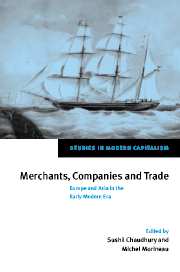Introduction
Published online by Cambridge University Press: 02 December 2009
Summary
It is almost common knowledge by now, thanks to the penetrating research by several scholars on maritime history in the last few decades, that the opening of the direct sea route from Europe to Asia around the Cape of Good Hope brought about an integration of trade on a global scale in the early modern era (roughly between 1500 and 1800). The main focus of the present volume is to highlight the growth and development of the international trade between Europe and Asia, especially India, between the sixteenth and eighteenth centuries which is extremely significant in the economic history of the world. This is the period when India was gradually incorporated into the capitalistic world system through oceanic trade with Europe. Encouraged by the Portuguese activities in the sixteenth century, various North European nations founded joint-stock companies in the early seventeenth century for trade in Asia, prominent among them being the English East India Company (EIC) and the Dutch Verenigde Oostindische Compagnie (VOC). The flow of silver from the ‘New World’ of America rendered trade between Europe and Asia easier. A portion of the silver which entered Europe from America was used in commerce with Asia. This, along with the silver that came from Japan, enhanced the purchasing power of the Europeans who were now in an advantageous position to procure goods for European markets.
- Type
- Chapter
- Information
- Merchants, Companies and TradeEurope and Asia in the Early Modern Era, pp. 1 - 18Publisher: Cambridge University PressPrint publication year: 1999
- 1
- Cited by



